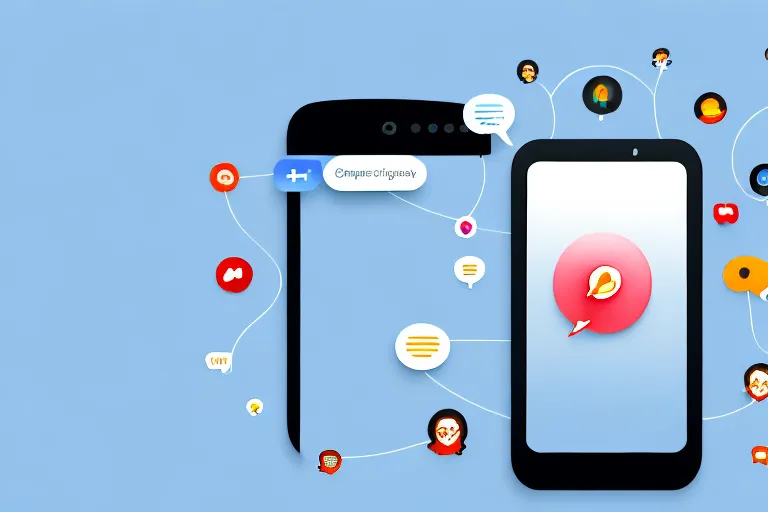RCS messaging, also known as Rich Communication Services, is a powerful and evolving technology that is revolutionizing the way we communicate. In this ultimate guide, we will explore the ins and outs of RCS messaging, its advantages over SMS, how to unlock its power, and its impact on various industries.
Understanding RCS Messaging
Exploring the Evolution of Messaging Technology
In order to truly understand the significance of RCS messaging, it's important to take a step back and explore its evolution. Over the years, messaging has come a long way from traditional SMS. From the introduction of MMS to the rise of popular messaging apps like WhatsApp and Facebook Messenger, communication has become more interactive and engaging.
With the advent of MMS (Multimedia Messaging Service), users were able to send and receive not only text but also images, videos, and audio files. This marked a significant shift in the way people communicated, as it allowed for a more visual and expressive form of messaging. Suddenly, a single message could convey not just words, but also emotions and experiences.
As smartphones became more prevalent, messaging apps like WhatsApp and Facebook Messenger gained popularity. These apps offered a range of features that enhanced the messaging experience even further. Users could now send voice messages, share their location, and even make video calls, all within the same app. The convenience and versatility of these apps made them a preferred choice for many.
RCS messaging builds upon this evolution, offering a richer and more immersive messaging experience. With features like read receipts, typing indicators, and high-resolution media sharing, RCS takes messaging to a whole new level.
The Advantages of RCS Messaging over SMS
While SMS has long been the go-to method of communication, RCS messaging offers a range of advantages that make it the clear winner in the messaging space. One of the key advantages is the ability to send rich media, such as photos, videos, and audio messages, without the limitations of SMS. This opens up a world of possibilities for personal and business communication.
Imagine being able to share a stunning high-resolution photo with a friend or send a funny video clip to brighten someone's day. With RCS messaging, these experiences are made possible, allowing for a more visually captivating and engaging conversation.
RCS messaging also offers improved group messaging capabilities, allowing for seamless coordination and collaboration. Whether it's planning a surprise party or organizing a team project, RCS enables real-time communication and efficient decision-making. With features like group chat, file sharing, and collaborative tools, RCS empowers users to stay connected and productive.
Additionally, RCS supports read receipts and typing indicators, providing a more interactive and dynamic conversation experience. Gone are the days of wondering if your message has been seen or if the other person is still typing a response. With RCS, you can instantly know when your message has been read and see when the other person is actively engaged in the conversation. This level of transparency and real-time feedback enhances communication and fosters better understanding.
In conclusion, RCS messaging represents the next step in the evolution of messaging technology. By offering a richer and more immersive messaging experience, RCS opens up new possibilities for communication and collaboration. With its ability to send rich media, improved group messaging capabilities, and support for read receipts and typing indicators, RCS messaging is revolutionizing the way we connect with others.
Unlocking the Power of RCS: A Guide for Users
RCS messaging, also known as Rich Communication Services, is a revolutionary technology that is transforming the way we communicate on our mobile devices. With its advanced features and capabilities, RCS offers users a more interactive and engaging messaging experience. In this guide, we will explore the timeline of RCS implementation and the availability of RCS messaging in the United States.
A Timeline of RCS Implementation
As RCS messaging continues to evolve, it's important to understand the timeline of its implementation. Major mobile carriers around the world have been working tirelessly to adopt and implement RCS, with varying degrees of success. Let's take a closer look at the key milestones in the journey of RCS implementation:
1. Initial Development: The concept of RCS messaging was first introduced by the GSM Association (GSMA) in 2008. The goal was to create a universal standard for advanced messaging that could replace traditional SMS and MMS services.
2. Early Trials: In the following years, several mobile carriers conducted trials and pilot programs to test the feasibility and functionality of RCS. These trials helped identify potential challenges and refine the technology.
3. Global Adoption: By 2016, RCS gained significant momentum, with major mobile carriers around the world committing to its adoption. This marked the beginning of a new era in mobile messaging, promising enhanced features such as read receipts, typing indicators, and high-resolution media sharing.
4. Interoperability Challenges: Despite the widespread adoption of RCS, achieving full interoperability between different carriers and devices has been a complex task. Technical and logistical challenges have slowed down the implementation process in some regions.
5. Ongoing Enhancements: As technology advances and user demands evolve, RCS continues to undergo enhancements and updates. New features like end-to-end encryption, chatbots, and advanced file sharing capabilities are being introduced to further enrich the messaging experience.
Keeping track of these developments can help users understand when and how RCS will be available on their devices. It's an exciting time for RCS messaging, and users can look forward to a future where communication is more seamless and engaging than ever before.
Availability of RCS Messaging in the United States
For users in the United States, the availability of RCS messaging can vary depending on the carrier. Some carriers have embraced RCS messaging, while others are still in the process of rolling it out. Let's explore the current state of RCS availability in the United States:
1. Verizon: Verizon Wireless was one of the early adopters of RCS messaging in the United States. They have fully implemented RCS across their network, allowing users to enjoy the advanced features and capabilities of this technology.
2. T-Mobile: T-Mobile has also made significant progress in implementing RCS messaging. They have partnered with Google to offer RCS messaging to their customers, providing a seamless and enhanced messaging experience.
3. AT&T: AT&T has been actively working on implementing RCS messaging, but the rollout has been slower compared to other carriers. However, they have made significant strides in recent years and are expected to fully support RCS in the near future.
4. Sprint: Sprint, now part of T-Mobile, has been actively supporting RCS messaging. With the merger of the two carriers, users can expect a more unified and consistent RCS experience across their network.
Users can check with their carrier to determine if RCS messaging is available on their device. It's worth noting that even if a carrier supports RCS, the availability may vary depending on the specific device and software version.
In conclusion, RCS messaging is a game-changer in the world of mobile communication. With its advanced features and capabilities, RCS offers users a more immersive and interactive messaging experience. By understanding the timeline of RCS implementation and the availability in your region, you can unlock the full potential of this exciting technology.
Who's on Board with RCS Messaging?
The Cross-Carrier Messaging Initiative and RCS Adoption
The Cross-Carrier Messaging Initiative, a collaboration between major carriers, aims to accelerate the adoption of RCS messaging. By working together, these carriers are paving the way for a unified messaging experience across different networks. This initiative is a testament to the potential and importance of RCS messaging in the future of communication.
RCS, or Rich Communication Services, is an advanced messaging protocol that offers enhanced features beyond traditional SMS. It allows users to send high-quality images, videos, and audio messages, as well as participate in group chats and see read receipts. With RCS, messaging becomes more interactive and engaging, bringing it closer to the experience offered by popular messaging apps like WhatsApp and iMessage.
Recognizing the potential of RCS messaging, several major carriers have joined forces to drive its adoption. This collaboration includes industry giants such as Verizon, AT&T, T-Mobile, and Sprint. By working together, these carriers aim to create a seamless messaging experience for their customers, regardless of the network they are on.
The Cross-Carrier Messaging Initiative focuses on implementing RCS messaging as the default messaging service on Android devices. This means that Android users will have access to RCS features without the need to download additional apps or rely on third-party messaging platforms. The initiative aims to make RCS the standard for messaging across all Android devices, ensuring a consistent and feature-rich experience for users.
One of the key advantages of RCS messaging is its ability to bridge the gap between different messaging platforms. With RCS, users on different networks can communicate with each other using advanced features like read receipts and typing indicators. This eliminates the need for multiple messaging apps and simplifies communication for users who switch between carriers or devices.
Furthermore, the Cross-Carrier Messaging Initiative aims to promote interoperability between carriers, ensuring that RCS messages can be exchanged seamlessly across different networks. This means that users will no longer have to worry about compatibility issues when messaging someone on a different carrier. RCS messaging will bring a new level of convenience and accessibility to communication, making it easier for people to stay connected.
As RCS messaging gains traction and more carriers join the initiative, the future of communication looks promising. The potential for a unified messaging experience across networks holds great value for both individuals and businesses. RCS messaging opens up new possibilities for enhanced communication, enabling businesses to engage with their customers in more interactive and personalized ways.
In conclusion, the Cross-Carrier Messaging Initiative is a significant step towards the widespread adoption of RCS messaging. With major carriers working together to implement RCS as the default messaging service on Android devices, the future of communication is set to become more seamless and feature-rich. RCS messaging has the potential to revolutionize the way we communicate, bringing advanced features and interoperability to messaging across different networks.
Enabling RCS Messaging on Your Device
...
To enable RCS messaging on your device, follow the steps provided by your carrier or device manufacturer. These steps may vary depending on your specific device and operating system. Once enabled, you can start taking advantage of the enhanced messaging experience that RCS offers.
Leveraging RCS Messaging for Marketing Success
Enhancing Verification Processes with RCS
...
RCS messaging allows businesses to send real-time updates to customers, keeping them informed and engaged. Whether it's a flash sale notification or a limited-time offer, RCS enables businesses to grab the attention of their customers instantly. This real-time engagement can drive higher conversion rates and boost overall marketing success.
Expanding Content Options for Maximum Impact
...
By leveraging RCS messaging, businesses can optimize their call-to-action and drive higher customer engagement. Whether it's a button to book an appointment or a link to a product page, RCS messaging makes it easy for customers to take action directly from the message itself. This streamlined process can lead to increased conversions and overall marketing success.
The Impact of RCS on SlickText
Valuable Resources for RCS Implementation
...
RCS messaging is an exciting technology that is transforming the way we communicate. By understanding its advantages, unlocking its power, and leveraging it for marketing success, businesses and users alike can tap into the full potential of RCS messaging. As RCS continues to evolve and gain traction, it's crucial to stay informed and adapt to this new era of communication.

